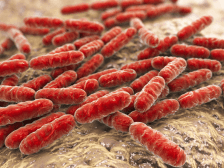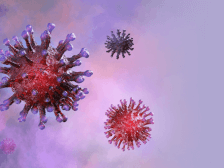What’s the Difference Between Germs, Bacteria, and Viruses?
What’s the difference between a germ, a virus, and bacteria? Let’s put these different disease-causing objects under a microscope and find out.
While shopping a few weeks back, just as fears about the coronavirus were reaching the United States, I came across the soap aisle. The shelves were barren of all the soaps labeled antibacterial, but plain old soap was still in plentiful supply. It seemed people didn’t realize that antibacterial soap isn’t any better at fighting viruses—plain old soap will do just fine. Antibacterial products are meant to deal with bacteria. Viruses and bacteria are not the same.
It’s been a challenge to get good, clear, accurate information during the pandemic. Not only is our understanding of the new coronavirus still evolving, but the messaging around it is often imprecise or outright wrong. Recently, President Trump said that “one of the biggest problems the world has is the germ has gotten so brilliant that the antibiotic can’t keep up with it.” Although it’s not clear whether he was specifically referring to the coronavirus as “the germ,” that ambiguity alone is confusing.
The hint about what the coronavirus is lies in the name—it’s a virus. Antibiotics won’t “keep up with it” because they’re not meant to fight viruses; they fight bacterial infections.
So, what is the difference between germs, viruses, and bacteria? Let’s clear that up.
What are germs?
The word “germ” is a catch-all phrase that can mean any microscopic particle that can cause illness in humans. The word germ comes from the Latin word germen, which means seed or sprout. That’s because early scientists studying germs thought about them as little seeds that spread between organisms.
The idea that disease-spreading organisms could pass from person to person existed as far back as ancient Greece. But before germ theory became widely accepted in the late 19th century, not all scientists believed in the idea of germs. In the Middle Ages—including during the time of the Black Death—the idea that tiny invisible things could make you sick if they touched you seemed far-fetched. Back then, the prevailing theory about how diseases spread was miasma theory. It held that rotting organic matter created a vaporous mist filled with disease-causing particles. It was believed that being in an area where “bad air” was present was the cause of disease.
The idea that disease-spreading organisms could pass from person to person existed as far back as ancient Greece.
Of course, we know that sanitation is important for controling the spread of disease. Although miasma theory got it wrong, the idea itself led to reforms and better sanitation. In fact, famous Crimean War nurse Florence Nightengale was a proponent of miasma theory. Her idea that foul-smelling vapors caused illness led to hospital sanitary reforms.
In the late 1800s, germ theory became widely accepted, thanks mainly to the experiments of Louis Pasteur and Robert Koch.
In modern times, the term “germ” isn’t widely used in formal science. Instead, disease-causing objects are referred to by what type they are. Viruses and bacteria are types of germs, as are certain types of fungi, protists, and prions.
 Bacteria
Bacteria
Bacteria are microscopic, single-celled organisms that live pretty much anywhere and everywhere, from the tops of mountains to the deepest sea vents. There are bacteria that live in water, soil, the air, clouds, your carpet, the ocean, and inside your body. Just how many types of bacteria are there? Nobody knows for sure. One paper on species numbers in bacteria estimates that there are “a million species of bacteria in 30 grams of rich forest topsoil and … at least a billion species worldwide.”
Fortunately, most bacteria are harmless. In fact, many bacteria are beneficial and help with metabolism and other aspects of human health.
But some bacteria definitely do cause disease. Once harmful—or “pathogenic”—bacteria enter your body, there are a variety of ways they can cause illness. Some species of bacteria cause infection of open wounds, others proliferate in your kidneys causing urinary tract infections. Other species affect the spinal cord, causing bacterial meningitis. Still others only grow in fluid inside the lungs, leading to bacterial pneumonia.
As wonderful as antibiotics are, they only work on bacteria. That’s the reason your doctor won’t presecribe antibiotics for the flu or the common cold.
Fortunately, many of these conditions can be treated with antibiotics—substances that either kill bacteria or slow their growth enough to allow your immune system to deal with them. As wonderful as antibiotics are, they only work on bacteria. That’s the reason your doctor won’t presecribe antibiotics for the flu or the common cold—both are caused by a virus, not bacteria.
 Viruses
Viruses
Viruses are tiny—smaller even than bacteria. In fact, the largest virus is still smaller than the smallest bacteria. Unlike bacteria, viruses can’t survive without a host.
Viruses are another type of object that causes illnesses in humans. Notice, I said “object” and not “organism.” That’s because there’s some debate among scientists as to whether or not viruses are alive. On one hand, they do contain genetic material (either DNA or RNA.) On the other, they can’t self-replicate in the absence of a host.
Our uncertaintly about whether viruses are alive doesn’t stop us from describing them in very alive ways. We call them “insidious” and refer to them as “invaders.” And, as I mentioned earlier, Trump may have even called them “brilliant.” One thing’s certain—viruses don’t have the capacity to think, let alone be tiny geniuses.
A virus consists of a small piece of genetic material (the DNA or RNA I mentioned) surrounded by a small protein capsule. While each virus operates a bit differently, they all basically float around until they bump into a compatible cell. Then they attach themselves to the cell and inject their genetic material. The cell is tricked into replicating the virus’s DNA, using the instructions it contains to build more viruses. The newly created viruses explode out of the cell, perpetuating the process.
Viruses are most notorious for making us sick, but they can be useful for genetic manipulation. The part that makes them dangerous to humans is the genetic material contained inside the lipid wrapper. That bit can be removed and replaced by beneficial genetic material to fix broken genes.
Another beneficial use of viruses is as super-selective antibiotics. One of the problems with antibiotics is that they tend to wipe out beneficial bacteria along with harmful bacteria, which can sometimes do more harm than good. However a special type of virus, called a bacteriophage, targets and destroys specific types of bacteria, leaving other strains alone.
Handwashing is important
Whether you’re hoping to avoid infection by a virus or bacteria, handwashing is the key to staying healthier. According to the Centers for Disease Control:
Keeping hands clean is one of the most important steps we can take to avoid getting sick and spreading germs to others. Many diseases and conditions are spread by not washing hands with soap and clean, running water.
Handwashing also helps prevent antibiotic resistance from making our antibiotics less effective at controlling disease. Because good hand hygiene helps us avoid getting sick in the first place, doctors don’t need to overuse antibiotics to treat bacterial illnesses. Antibiotic overuse contributes to the growth of resistant bacterial strains.
And, of course, good hygiene is essential to fight the spread of the new coronavirus. Here’s a video demonstrating proper handwashing technique.


 Bacteria
Bacteria Viruses
Viruses



